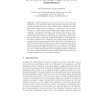828 search results - page 48 / 166 » A New Model of Program Dependences for Reverse Engineering |
CONCUR
2000
Springer
14 years 1 months ago
2000
Springer
Model checking based on the causal partial order semantics of Petri nets is an approach widely applied to cope with the state space explosion problem. One of the ways to exploit su...
POPL
2005
ACM
14 years 9 months ago
2005
ACM
We present a new approach to partial-order reduction for model checking software. This approach is based on initially exploring an arbitrary interleaving of the various concurrent...
ISCI
2007
13 years 9 months ago
2007
An obfuscation is a behaviour-preserving program transformation whose aim is to make a program “harder to understand”. Obfuscations are mainly applied to make reverse engineer...
KBSE
2007
IEEE
14 years 3 months ago
2007
IEEE
The paper presents a semi-automated technique for feature location in source code. The technique is based on combining information from two different sources: an execution trace, ...
CSMR
2010
IEEE
13 years 4 months ago
2010
IEEE
Abstract--Building comprehensive test suites for web applications poses new challenges in software testing. Coverage criteria used for traditional systems to assess the quality of ...

